Hello all! I want to thank the admin for allowing me to register here and ask for assistance! I've been trying to research this blade for the past couple of weeks, and while I have learned a lot, and gotten what I suspect is some pretty good information from a couple helpful souls on other forums, I'm still no closer to figuring out the Mei or general timeframe of this sword's history. What I can tell you is that this blade was found in my grandparents' estate. Grandfather was an officer in WWII, and spent a lot of time in Japan during occupation. We (I'm acting on behalf of my mother and her siblings) assume he brought it back with him at some point- whereupon it sat in the back of a closet for the last 50+ years. I've had a couple people from other forums tell me they think it's a tachi that was shortened at some point. Evidently this was common? I've spent quite some time going through the Mei database here, but frankly even if the signature is there, I might well have missed it. Definitely a difficult language to read if you're not used to it! |
|||
 |
Nihonto ClubJapanese Sword Information Exchange |
User login |
|
|
Disclaimer: Nihontō Club owners and independent contributors will not be held responsible for any loss, damage or inconvenience caused as a result of any inaccuracy or error within this website. Except where otherwise noted, this page is licensed under a Creative Commons License.
|
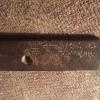


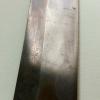

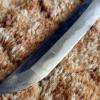
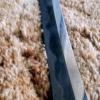
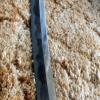

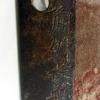
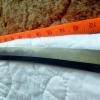
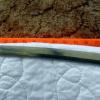
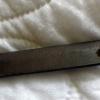


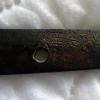
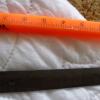
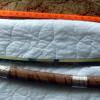

Tachi
I agree that it's a tachi that has been shorterned. The signature appears to read BI SHU OSAFUNE ? SUKE. I can't make out the next to last character. Sorry I can't be of more help.
Looks to be in great shape
Looks to be in great shape for a blade left in a closet for 50 odd years. Could be worth getting it looked at. I'd agree that it looks like a tachi, so could be a good bit of age to it. I'd no luck with the second to last character either.
SUKE-something
It is Bishuu Osafune Suke-something.
The "something" is where it was cut off.
The second-to-last kanji is the second kanji is "Osafune".
Pete
edge
I'm wondering about the thin parallel line I see at the cutting edge?
I hope it hasn't been "sharpened" on a knife-sharpener...
It may actually have been made to be mounted as a TACHI, but note that it is signed "katana-mei". Specifically: When worn on the left hip, with the signature facing outwards, if the edge is up, then it's a katana; if the edge is down, then it's a tachi.
The SORI (depth of curvature of the blade) looks fairly deep.
Pete
If the bottom of the
If the bottom of the signature has been removed the most common name seems to be Sukesada. I found this "The Bizen Sukesada line of swordsmiths descended in the Osafune school and are recorded as far back as the end of the Nambokucho period (around 1394). At the end of the Muramachi period the demand for mass produced swords was high and the Sukesada name (or brand) had a strong reputation as producers of good martial quality fighting swords. At this time more than 40 swordsmiths used the Bizen Sukesada name and in collectors circles, Sukesada is commonly linked to Kazuuchimono ( bundle swords) of the Sengoku time of war. But to conclude that all Bizen Sukesada swords are of mass produced quality is a mistake.
The early Sukesada smiths produced swords of outstanding quality. Hikobeijo and Yososaemonjo Sukesada are both ranking O-Wazamono and Fujishiro gives them both Saijosaku rankings. The Kazuuchimono swords were produced from around Tenbun (1532) to the end of Tensho (1591), after the introduction of firearms, changes in battle tactics and the birth of the Ashigaru infantry. Due to the high demand for swords during the tumultuous later Koto years each maker produced various qualities of blades."
Don't know how reliable it is.
Sukesada
I agree with other posters. Few more observations:
Here's a somewhat similar example: http://www.ricecracker.com/inventory/678_wak_sukesada/678_wak_sukesada.htm
It's impossible to say whether this hypothesis is correct without examining the sword in person.
Stan
Hey wow thanks for all this
Hey wow thanks for all this info! Now we're getting somewhere!
Assuming the mei is/was Bishuu Osafune Sukesada, then I gather this was an upper-mid-grade (3 out of 5) sword in its day?.. following the info on the website for Looper's quote-
Level 3 “ Jo Saku” Upper or above average class, produced for medium to higher ranking samurai . 6 character mei “Bishu Osafune Sukesada or “Bizen Osafune Sukesada” . swords of this quality show fine features.
I'm also intrigued by the notion set forth by kazarena. Essentially, what you're hypothesizing is it might be a forgery...or perhaps "homage" would be a better word? Made in the 1800's to resemble a shortened 1500's tachi if I'm understanding correctly. I assume that's not necessarily a bad thing so long as the quality is there, yes? Or, of that is the case, does that really hurt its value?
To address some of the other things brought up in the thread:
I'm wondering about the thin parallel line I see at the cutting edge?
I hope it hasn't been "sharpened" on a knife-sharpener...
It may actually have been made to be mounted as a TACHI, but note that it is signed "katana-mei". Specifically: When worn on the left hip, with the signature facing outwards, if the edge is up, then it's a katana; if the edge is down, then it's a tachi.
The SORI (depth of curvature of the blade) looks fairly deep.
Pete
I see the line you're talking about. It's some sort of trick of the lighting with the photograph. I've since taken it out and examined it again and there really is no western style "bevel", or attempt at one on the edge. And the aging looks to be consistent all the way down. There are even a few small chips here and there. Nothing big enough to harm the value much though (<1mm).
Like you, I noticed the orientation of the signature, that it's in a katana rather than tachi facing direction. Intriguing since most seem to agree it's a shortened tachi... how strict were they on the "rules" as far as things like that go?
Personally, I think the butt of the tang seems to match the rest of the tang as far as color and age go. If it had been shortened maybe it was pretty early after it was made? Or perhaps it supports kazarena's theory that it was made that way intentionally.
However, on the other side of the coin, kazarena notes "both mekugi-ana have reasonably sharp sharp edges". Maybe true, but the hole nearest the mei is definitely not as clean or round all the way through as the one farther up. To me it looks like something that might have been added later...which would support the shortening theory. As you said, it's something you have to see in person to actually "see" I guess.
This has become quite an interesting thing. Partly because of this sword's unusual/questionable characteristics, and partly because it has really opened my eyes to the absolutely amazing work of Japanese bladesmiths. To think they were putting out this quality of work at a time when the rest of the world was pretty much still cutting stuff with sharp rocks. Astounding.
I can take more pictures later this week if anyone wants. Possibly with a better camera. I can probably get a close-up of the edge and the mekugi-ana. I also have a micrometer so can take measurements of anything that might be useful.
Again, thanks for all the help to this point!
The only way you'll get a
The only way you'll get a definitive opinion would be to take it to a shinsa. If you're in the US there should be one at some point. There's only so much anyone can say for sure from photos. I think it would worth getting a solid appraisal.
I find it odd that the last character of the smiths name has been removed. Considering that normally every effort is made to preserve the mei.
Do you have any of the fittings, tsuba, handle ect?
Shin-Shinto
Essentially, what you're hypothesizing is it might be a forgery...or perhaps "homage" would be a better word? Made in the 1800's to resemble a shortened 1500's tachi if I'm understanding correctly. I assume that's not necessarily a bad thing so long as the quality is there, yes? Or, of that is the case, does that really hurt its value?
Personally I would prefer a good Sukesada blade from Shin-Shinto to a run-of-the-mill Muromachi Sukesada. Whether it can be qualified as forgery or just a later Sukesada - it's hard to tell, only Shinsa or other appraisal in person would.
Stan